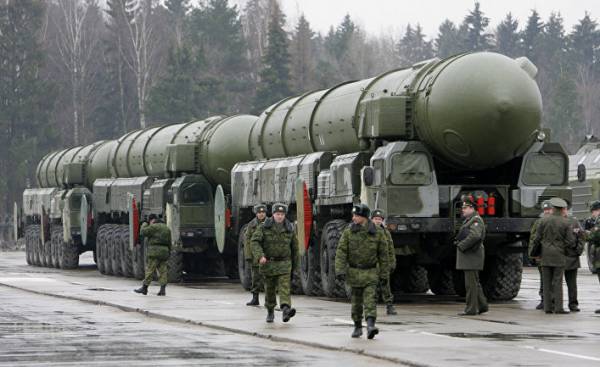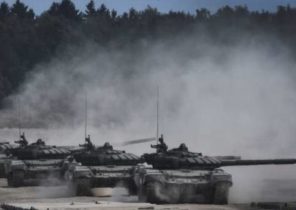
The new Russian Intercontinental ballistic missiles will be capable of breaking through any missile defense system the United States.
This was stated by Vice-Premier of Russian government Dmitry Rogozin in an interview on the TV channel “Russia 1”. Deputy Prime Minister confirmed that the R-36M2 “Voivod” (known in the West as SS-18 “Satan”) will continue to be used for strategic forces until, until testing of the new system “Sarmat”, which should be operational by next year.
“Our strategic component is very efficient and reliable. Soon the Russian Federation will be protected by a new missile system that can withstand any current and future system of defense”.
Missile forces of Russia used a number of R-36M utth/SS-18 Mod 4 and R-36M2 “Voevoda” (SS-18 Mod 6). The first is “improved tactical and technical characteristics”, she accommodates up to ten MIRV warheads (multiple warheads with individual guidance units — approx. ed.), CEP (circular error probable — approx. ed.) of 220 meters.
“Sarmat”
It is assumed that developed from 2015 in response to the American initiative of the BSU (prompt global strike, Prompt Global Strike) complex with liquid rocket in 2025 will account for 80% of all nuclear missiles of a class “earth — earth”. Few weeks to begin flight tests. The first stage of the test rocket motor was a success, was resolved technical problems with the previous prototype. Intercontinental ballistic missile will replace the R-36M2 “Voivod” divisions, located near Krasnoyarsk, Eastern Siberia and Orenburg, and southern Urals. The huge size of the rocket required a redesign of the bunkers on the Plesetsk space centre in Northwest Russia. Fusion rocket weighing more than 100 tons falls into the category of super-heavy systems: it is capable of hitting targets at a distance of more than 12 thousand kilometers.
It should reach speeds of up to 20 M and to release the 10 heavy or 15 light warheads that can move along independent trajectories. Moscow continues to develop maneuverable warheads, despite the fact that all the forces are concentrated at supersonic resources. The new ICBM will be adopted for use in the seven divisions of the strategic rocket forces of the Russian Federation. As “Sarmat” and “Satan” exceed its capacity the us rocket Minuteman, which is subject to modernization will remain in operation until 2030. Supersonic platform, which will be implemented in 10-15 years will dramatically change the very concept of NMD. Systems such as “Sarmat”, require the reform of the system of deterrence.
To attack the United States
This system called and a missile defense shield, and the network actinospore defense. No matter how it was called, we are talking about a system that can only hope to intercept a few missiles launched in North Korea or Iran. That is a given.
The United States is protected by using Ground-based missile defense system to cruising flight (Ground-based Midcourse Defense), designed to intercept ballistic missiles long range. 44 interceptors placed at Fort Greely in Alaska and at the military air base Vandenberg in California. Missile created based on natmosphere interceptor — kinetic system, which, using data from ground radar and onboard sensors to identify and destroy in outer space missiles aimed at the United States. This line of continental defense it is necessary to add 33 units Aegis of the U.S. Navy equipped with SM-3 interceptors. The us missile defense system will be integrated with the missile defense system of NATO in Europe. Firing points and space defense of the US/NATO are located in Poland and Romania. The Mediterranean sea, like the Adriatic and the Ionian, is the basis of the combat system resources with a constant rotation of missile cruisers “Ticonderoga” and “Arleigh Burke” since 2011. Two points of the system of missile warning radar located on Fylingdales and Turkey. Mobile device surveillance radar AN/TPY (Army Navy/Transportable Radar Surveillance) was deployed on the basis of Karadzic in Turkey in January 2012.
The missile defence programme was designed to intercept missiles fired in Iran or North Korea — and this is its fundamental point.
Existing technologies are simply not able to provide reliable protection against a massive missile attack from China or Russia. The kinetic interceptor is still considered unreliable and unsuitable for total reflection of systematic threats, for example, against the attack of hundreds or thousands of warheads with independent trajectory.
To date, the US has 50 to 70% chance to intercept an enemy warhead in space. And it is also a fact: one of two rockets will be able to produce warheads that could hit targets on U.S. soil.
None of the defense system in the world will not be able to repel carpet attack, but it’s not going to start suddenly and not pass warning system. Approaching the well known points will certainly fix ground-based radars on the East and West coast of the United States, and will monitor from space. It is likely that a pre-emptive strike Russia or China could catch the US by surprise and disrupt chain of command. In any case, in the sea there are always from four to eight strategic submarines of the United States, ready to launch in case you need cover for possible targets. If at least one submarine class “Ohio” will start all 24 kept on Board the missile UGM-133A Trident II (D5), it will produce up to 192 nuclear warheads with independent movements, able to wipe off the face of the earth 24 of the metropolis. The entire fleet “Ohio”, consisting of 14 submarines, capable of destroying life on the planet. And not just once.





